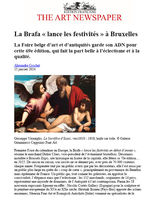
For the first time since the establishment of their alliance, the galleries Le Minotaure, Kaléidoscope, and Alain Le Gaillard are designing a joint exhibition to explore a new theme : Three Little Surrealist Stories. They are teaming up with the Jacques and Thessa Herold Collection and offer us a surprising journey back in time, from the present day to 1924, made up of unexpected connections: from Yayoi Kusama's psychedelic shoes to Jean Arp's biomorphic compositions; from Antonio Recalcati's portrait of Apollinaire, in the style of De Chirico, to Kandinsky's enigmatic lands; from Louise Bourgeois' painful arrangements to Ervand Kotchar's fruity eroticism.
Ce processus de disqualification va ensuite se confirmer au profit du corps, de la figure humaine, combinée aux objets, pour exprimer dans la peinture les enjeux politiques, sociaux, sexuels, culturels de l’époque.
Néanmoins, à partir du milieu de la décennie suivante, plusieurs peintres des Nouvelles figurations vont renouer avec ce genre : Antonio Recalcati, Henri Cueco, Lucio Fanti, Jacques Grinberg, Gilles Aillaud...
Et le grand amoureux de la peinture, Gérard Gasiorowski, n'a eu de cesse de revenir au paysage tout en le maltraitant : séries Les Croûtes, La Fuite du côté de Barbizon, Les Ponctuations, Les Cérémonies, Les Paysans.
Exposition du 18 octobre au 31 janvier 2026
Du mardi au samedi, de 11h à 19h
Lien vers le dossier de présentation de l'exposition
Established in 2019, the Kaléidoscope Gallery champions artists who left their mark on the second half of the 20th century and supports contemporary creators by creating spaces for juxtaposition and dialogue between generations.
We particularly focus on painters who were active in the Parisian art scene during the 1960s and 1970s, many of whom came from all corners of the world to form a true figurative avant-garde.
Through close collaborations with estates, museums, and art historians, we aim to shed light on this remarkable flourishing of figurative painting in Paris, commonly referred to as "Nouvelle figuration" (New Figuration).

























